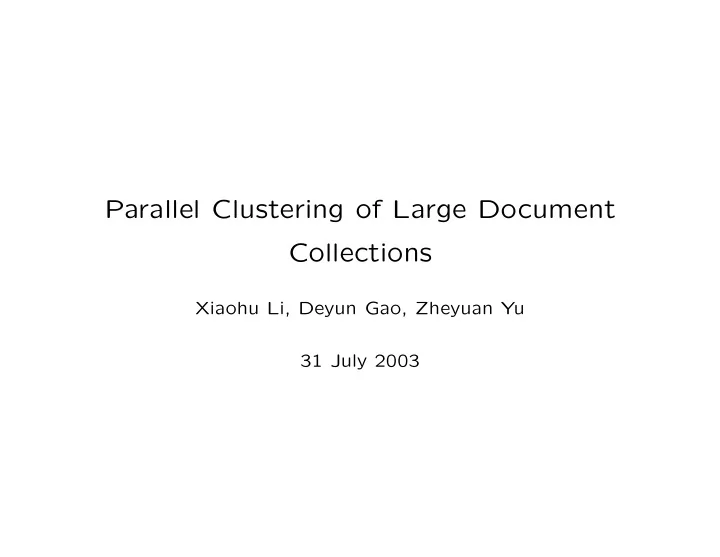

Parallel Clustering of Large Document Collections Xiaohu Li, Deyun Gao, Zheyuan Yu 31 July 2003
Document clustering is the process of organizing documents into clusters so that • Documents within a cluster have high similarity in comparison to one another. • But are very dissimilar to documents in other clusters. 1
An application of document clustering 2
Previous Works • Hierarchical Methods: – Agglomerative and Divisive. – Reasonably accurate but not scalable. • Partitioning Methods: – Efficient, scalable, easy to implement. – Clustering quality degrades if an inappropriate number of clusters is provided. 3
Vector Space Model • Each document is represented by n-vector d i of term weight. • term weight: term frequency (tf), inverse document fre- quency (idf). w i,j = 0 if a term is absent • Each direction of the vector space corresponds to a unique term in the document collection • Vectors assembled into Term Frequency Matrix M = ( d 1 , d 2 , ..., d m ) 4
A Term by Document Matrix 5
Challenges in document clustering • High dimensionality. K. Beyer et. al.[1] have shown that in high dimensional space, the distance to the nearest data point approaches the dis- tance to the farthest data point. The similarity measure of the clustering algorithms do not work effectively, hence the meaningfulness of clustering may be doubtful • High volume of data. • Consistently high clustering quality. 6
Our goal To fight the challenges of document clustering, we want to ob- tain an scalable and effective parallel document clustering algo- rithm with reasonable speed up. 7
Principal Direction Divisive partitioning • based on the principal component analysis instead of tradi- tional distance or similarity measure, reported to be scalable and effective. • Related Methods - Principal Component Analysis – PCA: To discover or to reduce the dimensionality of the data set. – LSI – PDDP computes just first eigenvector. 8
Principal Direction Divisive partitioning (Cont) • Get leading principle direction u of M − we T with SV D , where w = 1 i =1 d i = 1 � m m Me , e = (1 , 1 , ..., 1) T m • Split documents by value of projection u T ( d j − w ) , j = 1 , 2 , ... • Repeat the process on each cluster recursively 9
Principal Direction Divisive partitioning - Splitting Steps 10
Approach - Algorithm Issues: Fast Lanczos Solver • Total cost dominated by cost of finding principal direction. • Use efficient sparse matrix eigensolver ”Lanczos”. • Matrix used only to form matrix-vector products. • Use Bisection and Sturm sequence to find the largest eigen- value. 11
Our improvement for implementation of Lanczos • Covariance matrix multiply vector: Cv – Lanczos algorithm computes Cv for each iteration – If C = ( M − we T )( M − we T ) T is calculated directly, the sparsity of the matrix is destroyed. – To keep the sparsity and avoid matrices multiplication for memory and computational efficiency: we implement Cv = ( M − we T )( M − we T ) T v as M ( M T ) v − Mew T v − we T M T v + we T ew T v 12
Our improvement for implementation of Lanczos • Bisection Sturm Sequence Algorithm – In Lanczos algorithm, the most time consuming step is to get the largest eigenvalue of tridiagonal T . – In PDDP algorithm the general approach to compute the largest eigenvalue by getting all the eigenvalues and pick- ing the largest one. – Bisection sturm sequence algorithm can directly compute the largest eigenvalue of tridiagonal matrix T 13
Principal Direction Divisive partitioning (Cont) Data Sets: • D1: 2340 docs, 21,839 words • D3, D9, D10: reduced dictionaries – D3: 8104 words – D9: 7358 words – D10: 1458 words 14
Data Storage and Distribution • Represent set of document by term-by-document matrix • The matrix is vary sparse • Choose Compressed Sparse Row (CSR) storage format 15
Data Storage and Distribution - Continue Comparison of matrix storage Save storage cost: from MxN to (2xNz+N+1) • Save storage cost: from MxN to (2xNz+N+1) 16
Reduce time complexity for Matrix Vector multiplication 17
Data Distribution for Parallel • Matrix vector multiplication is one of the most time consum- ing operations. • Data allocation is performed by rows. 18
Data Distribution for Parallel - Continue • During the processing, document set is divided into clusters • Corresponding matrix is also divided vertically into sub-matrices. • Only need local column re-allocation 19
Evaluation Sequential Running Time 3500 3000 2340×1458 2500 Running Time(s) 2000 1500 1000 500 185×1328 0 98×1004 0 500 1000 1500 2000 2500 Document Size 20
Evaluation - Continue 21
Evaluation - Continue • Evaluate speedup of the whole application • Evaluate with larger document set • Cluster quality evaluation: Entropy Purity • Compare with other document clustering algorithm, such as K-means. 22
REFERENCES 1. K. Beyer et. al., When is nearest neighbor meaningful?, In proceeding of the 7th ICDT, Jerusalem, Israel, 1999 2. D.L. Boley, Principal Direction Divisive Partitioning, Tech- nical Report TR-97-056, University of Minnesota, Minneapolis, 1997 3. ShuTing Xu and Jun Zhang, A Hybrid Parallel Web Document Clustering Algorithm and Its Performance Study, Technical Re- port No. 366-03, Department of Computer Science, University of Kentucky, 2003” 23
Recommend
More recommend